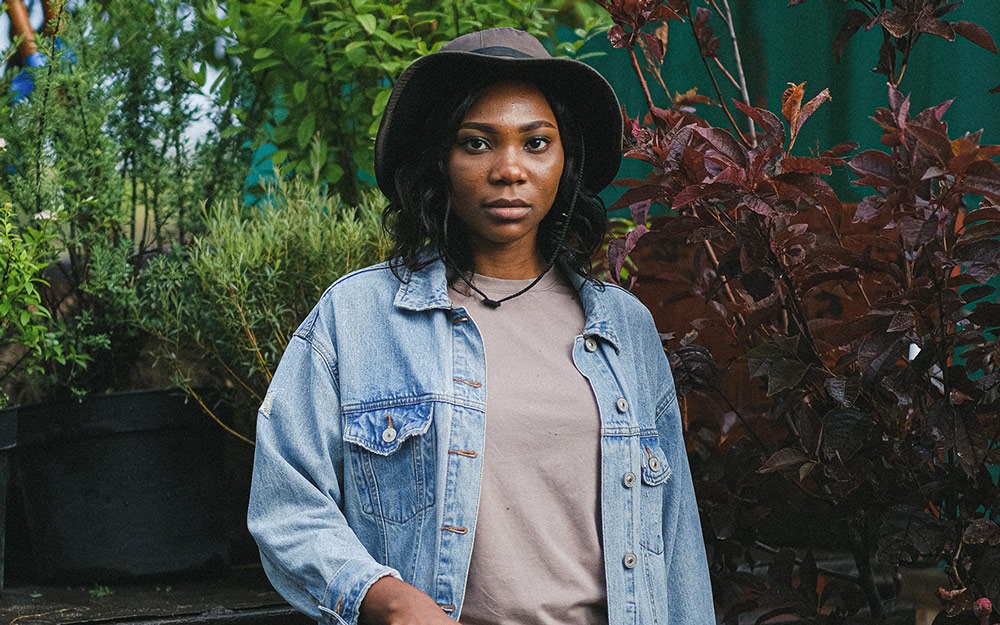

This article introduces Black Food Sovereignty: Stories from the Field, a series co-produced by Frontline Solutions and NPQ. This series features stories from a group of Black food sovereignty leaders who are working to transform the food system at the local level. It explores how these leaders are addressing critical issues at the intersection of food sovereignty, racial and economic justice, and community.
It’s a little before 7am, and the hum of the airplane’s engine is interrupted by the sound of the plane’s wheels deploying. I’m on my way to visit Soul Fire Farm in Petersburg, New York (a small town about 30 miles east of the state capitol of Albany). The farm is a member organization of the National Black Food and Justice Alliance, where I work. Before the plane touches down, I gaze out the window at a sea of lights that weave through the changing landscapes and line the highways that connect large stretches of farmland to urbanized areas.
What I really see, I note, is not just lights but a story about power. Before my eyes stretches a masterfully engineered network of infrastructure built on wealth acquired through the dispossession of Indigenous people and extraction from both the land and the people who labored on it. Many of these laborers were Black, and they were prevented from accumulating the wealth they created, segregated, and denied access to resources. For example, during the Great Depression and the decades that followed, in a process called redlining, the government-sponsored Home Owners’ Loan Corporation and the Federal Home Loan Bank Board systematically denied loans to Black and Brown folks, excluding them from home ownership.
This exclusion had consequences not just for the posterity of Black families, but for Black health. Black people who couldn’t access federal loans to buy homes in the suburbs were often relegated to industrialized areas, where exposure to toxic waste and other environmental hazards is unavoidable. In Louisiana, for example, 45,000 people live in a region known as “cancer alley.” As a 2021 United Nations report condemning environmental racism in the United States noted, most of these people are Black.
Of the farmland that remains tilled in the United States, 846 million acres are held by white farmers, compared to less than 60 million acres farmed by Indigenous families and less than five million acres by Black families.
As the country moved to a corporatized food system, and as chain grocery stores became the only point of access to fresh and healthy foods, such chains avoided redlined communities in major urban centers. These communities still live under food apartheid. The reservations to which Native Americans were relegated have some of the poorest soil in the United States. Meanwhile, Black-owned farmland has almost disappeared over the past century, taken by overt force, predatory lending, and lack of access to financial resources.
Of the farmland that remains tilled in the United States, 846 million acres are held by white farmers, compared to less than 60 million acres farmed by Indigenous families and less than five million acres by Black families. In other words, Black farmers hold an estimated 0.52 percent of all US farmland. In 1900, Black farmers made up 14 percent of all US farmers; today, their share of the farming population is 1.4 percent. As we’ve seen with the year-long battle to include debt relief for Black farmers in the American Rescue Plan Act, Black farmers continue to face insurmountable odds.
Food insecurity and malnutrition are rising rapidly due to rising food costs. Water infrastructure in Jackson, Mississippi, a predominantly Black community, is failing. Climate catastrophes are becoming more frequent and deadlier. While Black and Brown folks on the frontlines often feel crises like the climate emergency first, these systems are not just failing Black people; they are failing everyone. No one living today is responsible for the systems on which this country was founded. However, we are all responsible for creating just, sustainable solutions to the problems we face.
Learning from History
History teaches us that solutions to social problems are most likely to come from communities that have been excluded from the social good.
For instance, in 1969, two Black cooperative models were established in response to the racial violence and lack of access to resources and opportunity that Black people continued to endure during the civil rights and Black power movements. Freedom Farm Cooperative in Sunshine County, Mississippi, was created after Fannie Lou Hamer was fired and evicted for registering to vote as a sharecropper. The cooperative, which sought Black self-sufficiency, offered affordable housing, entrepreneurial opportunities, and education to tenant farmers, as well as a pig bank and access to fresh produce to feed families living in poverty.
Sign up for our free newsletters
Subscribe to NPQ's newsletters to have our top stories delivered directly to your inbox.
By signing up, you agree to our privacy policy and terms of use, and to receive messages from NPQ and our partners.
That same year, the first community land trust, New Communities, established by a collective of civil rights and land activists, including Charles and Shirley Sherrod, took 5,700 acres off the speculative market to be stewarded by Black farmers to feed their rural South Georgian community and protect the ecosystem through regenerative agricultural practices.
Soon after, the Black Panther Party established free medical clinics as well as a free breakfast program. Adopted by the federal government in 1975, the program still feeds 14.5 million school-aged children every day. From cooperative land models to free programs and mutual aid, we have the ability to imagine beyond racial capitalism and achieve the resilience that comes with working collectively in our communities and families.
The Struggle for Food Sovereignty Today
Today, in Baltimore, the Black Church Food Security Network is creating systems to distribute fresh, healthy foods from Black growers to churches up and down the Eastern seaboard. Grow Greater Englewood is revitalizing Chicago’s Englewood neighborhood by developing food enterprises and supporting community ownership of land in a historically underserved community.
The Resource Commons, a member-led initiative of the National Black Food and Justice Alliance (NBFJA), is working to liberate land from the speculative market and secure it for sound ecological, social, and financial stewardship by Black farmers, foresters, and community gardeners. Over 100 acres were transferred this year. NBFJA also launched the Lola Hampton-Frank Pinder Center for Agroecology at Florida A&M University, a research and training center that seeks to steer the next generation of farmers and land stewards towards practices that will heal the earth and our communities and mitigate climate catastrophes.
Then there are the inspiring stories of the people featured in this series on Black food sovereignty. In Camden, New Jersey, the Camden Dream Center is developing a new vision for urban agriculture, utilizing vertical hydroponic farming to advance food justice for the city’s majority Black community. In the Raleigh-Durham region of North Carolina, the Black Farmers’ Market is supporting Black farmers and building community, while the Black Farmers’ Hub provides a retail outlet. Meanwhile, at Tugaloo College—a historically Black college in Jackson, Mississippi—the newly formed Reuben V. Anderson Center for Justice has launched the Tougaloo Agri-Growth Initiative, which is backing a network of worker-owned cooperative farms.
Many of these efforts are small, but together they constitute a larger emergent movement.
Envisioning Our Movement’s Future
Ensuring a route towards Black food sovereignty is necessary to addressing all that lies at the intersection of food and land justice.
Back in my airplane, as it descends, I ask myself: “What would Black food sovereignty look, feel, and taste like?” What would the array of lights out my window look like in a world where Black and Brown people self-determine and build systems that support the health and stability of Black and Brown communities? Ensuring a route towards Black food sovereignty is necessary to addressing all that lies at the intersection of food and land justice. It has implications for labor rights, immigrant rights, economic justice, and gender equity. It can help lead us towards a climate resilient future.
As Fannie Lou Hamer said, “There’s got to be a change—not only for Mississippi, not only for the people in the United States, but people all over the world.” The grassroots organizations that make up the National Black Food and Justice Alliance and the people featured here give me hope for what’s possible on the other side of the horizon.











